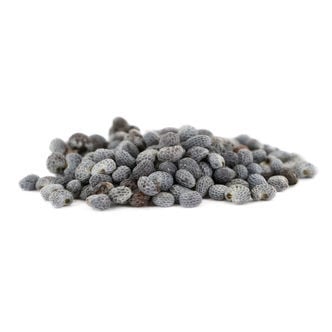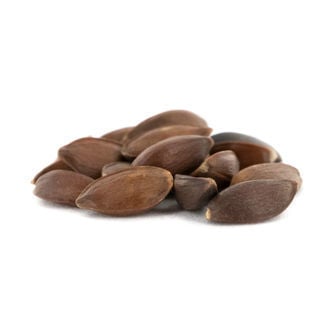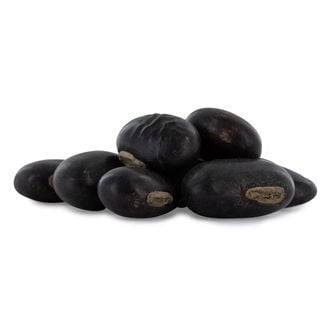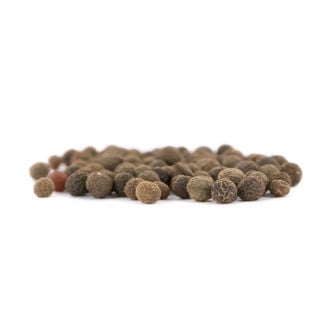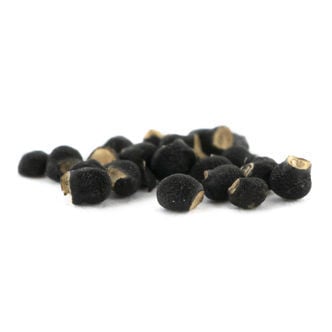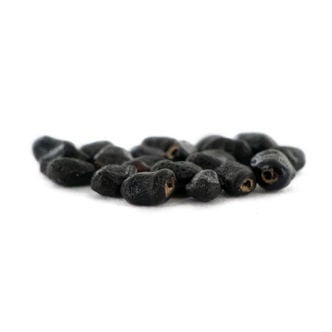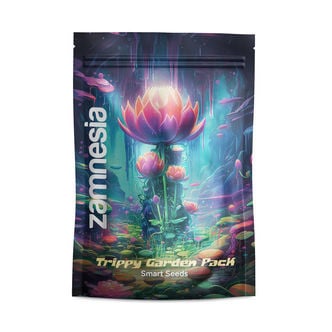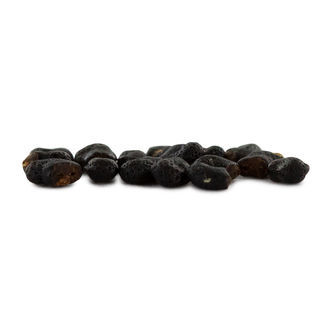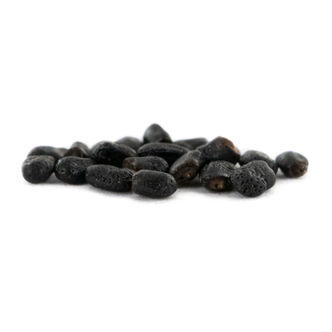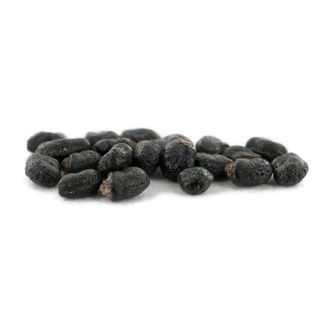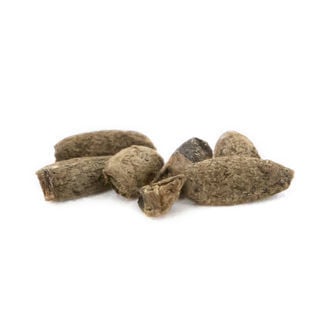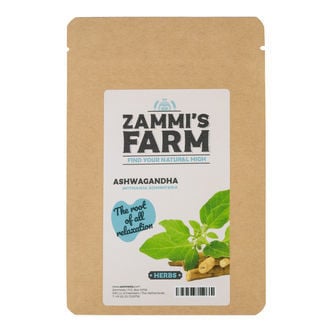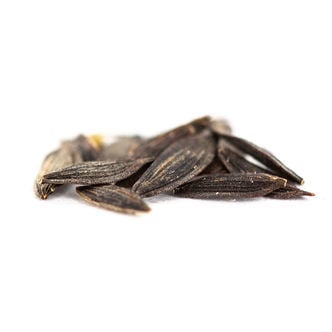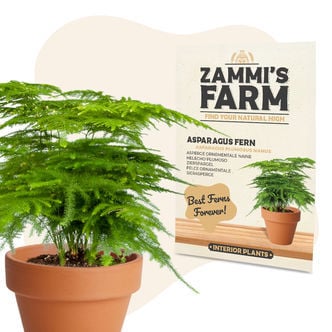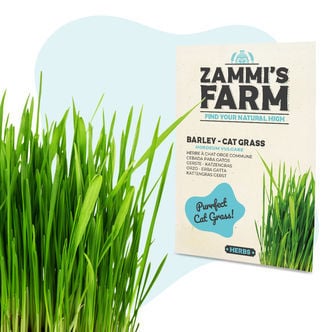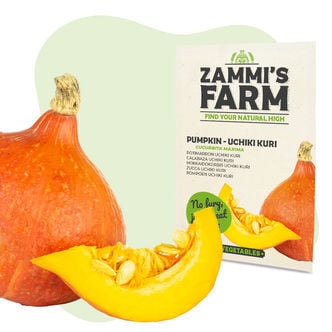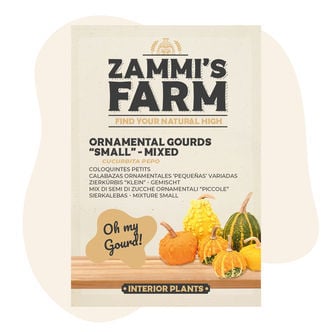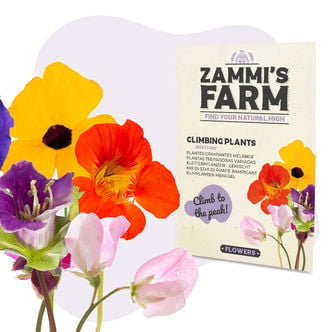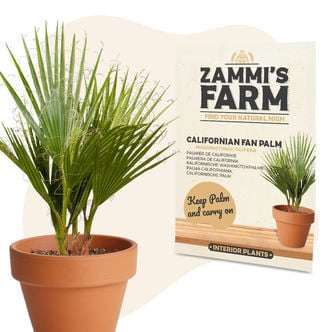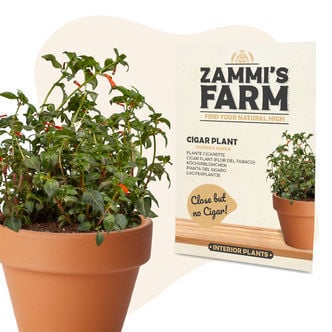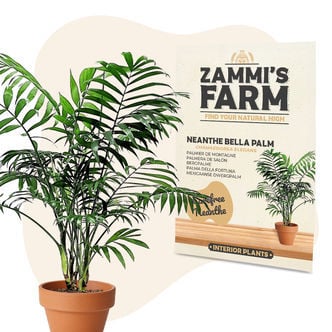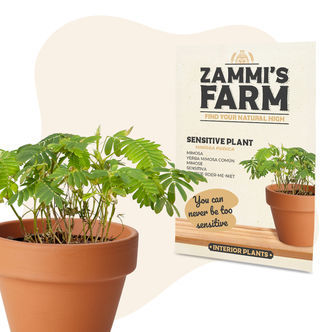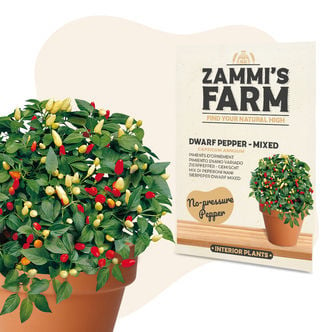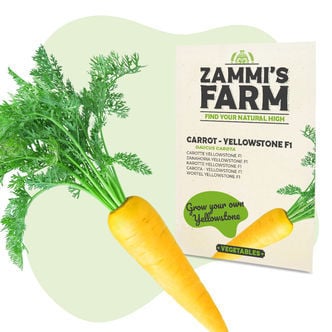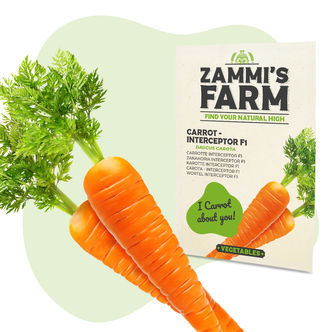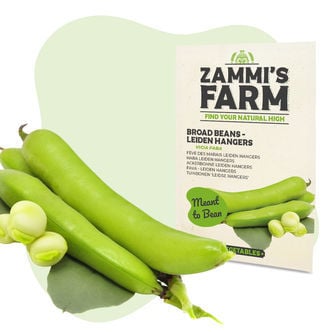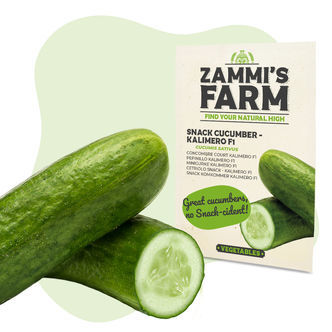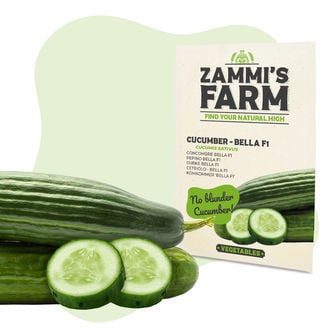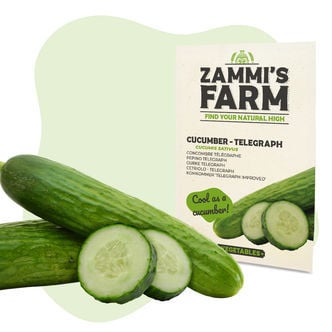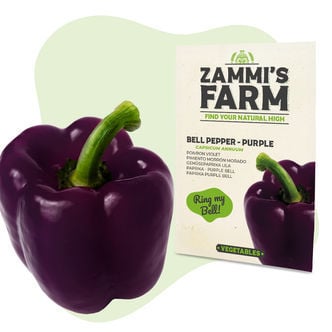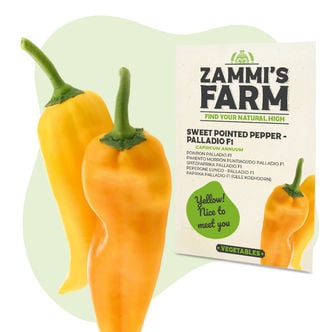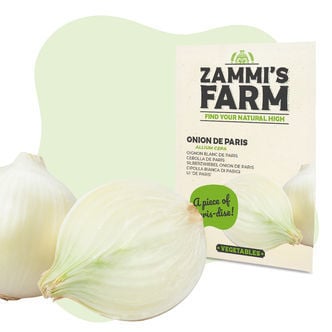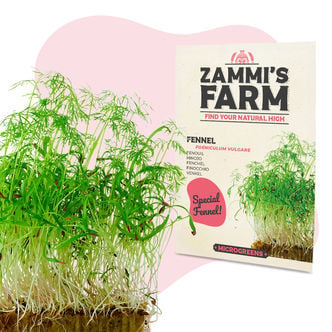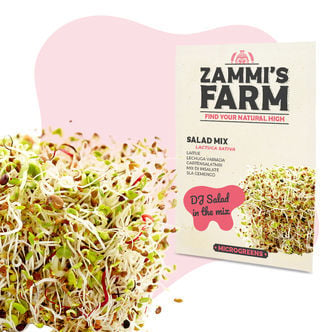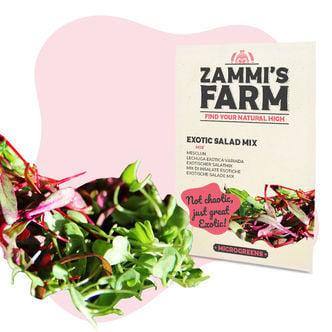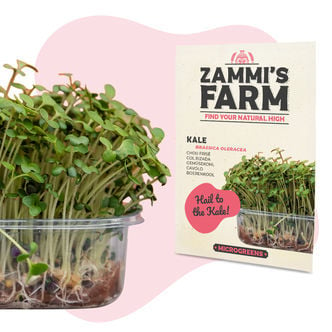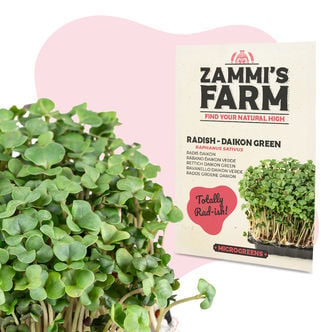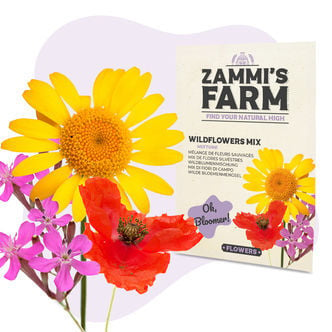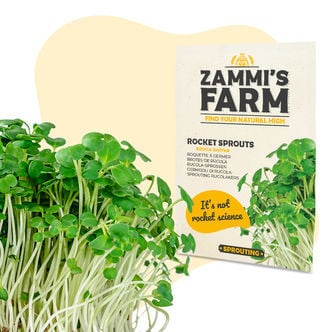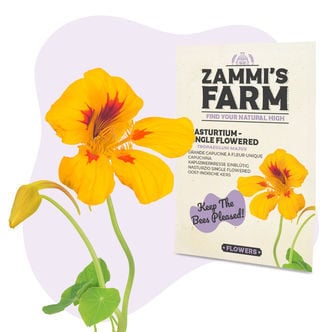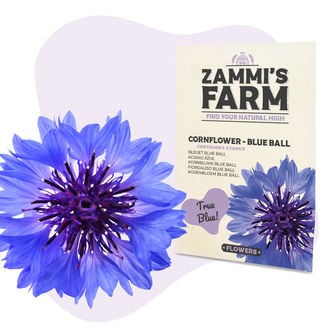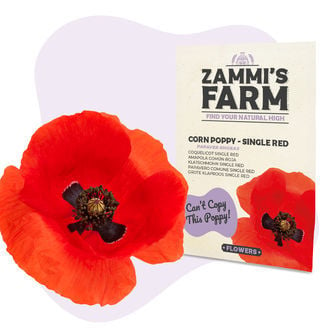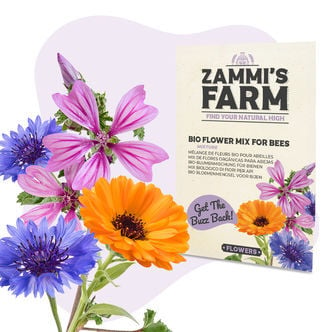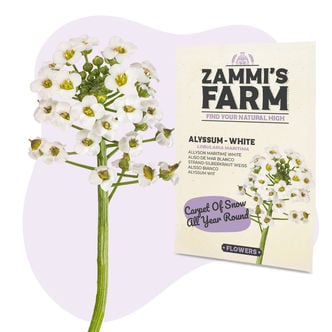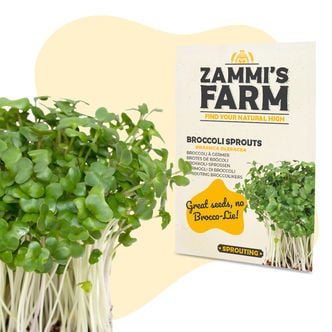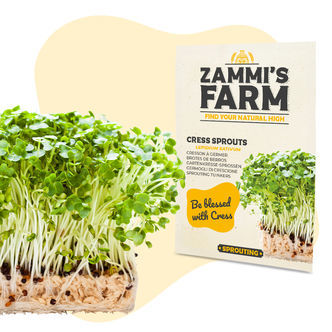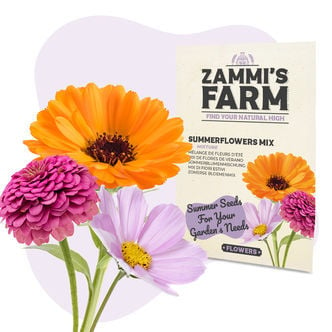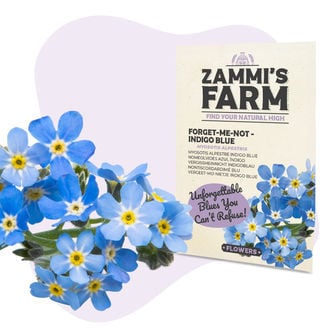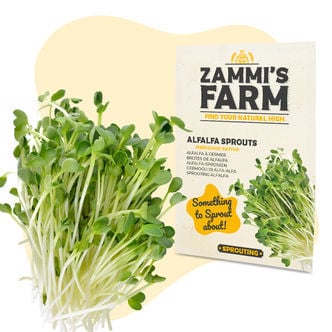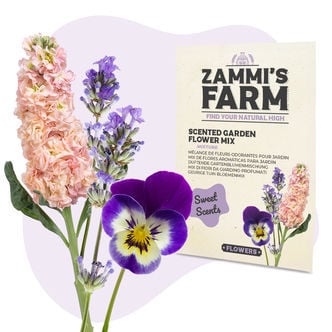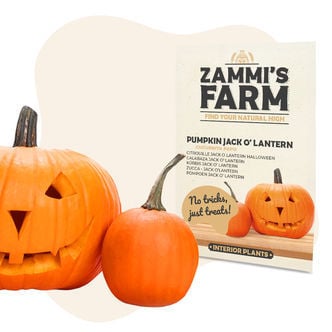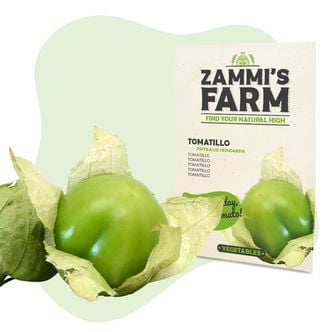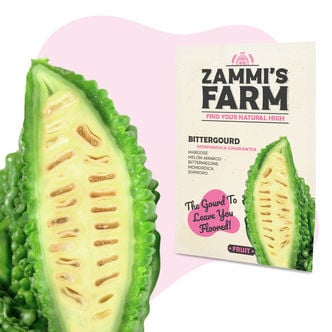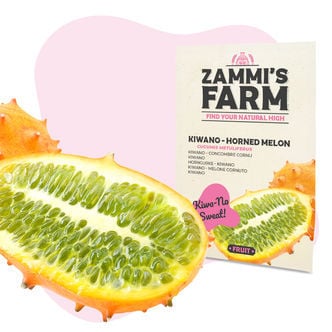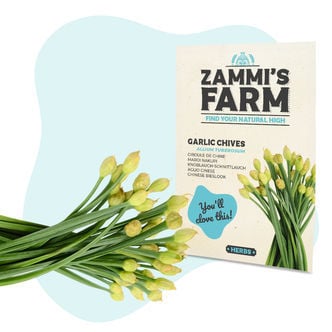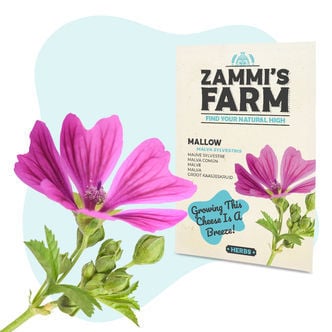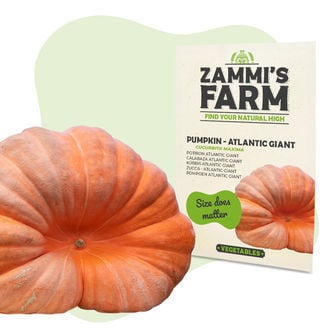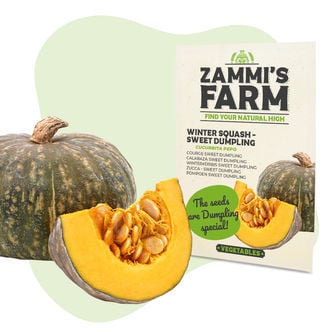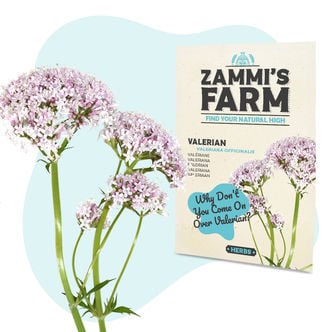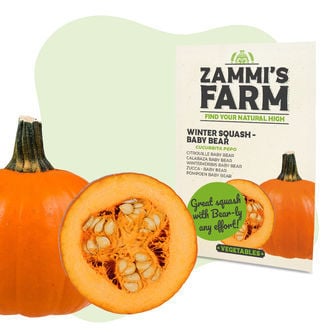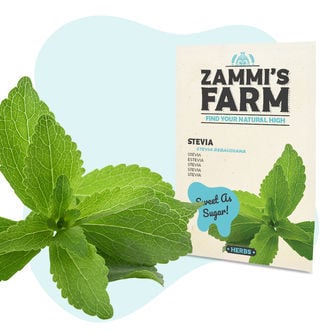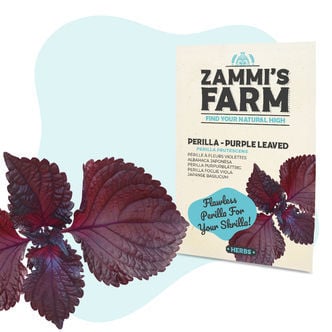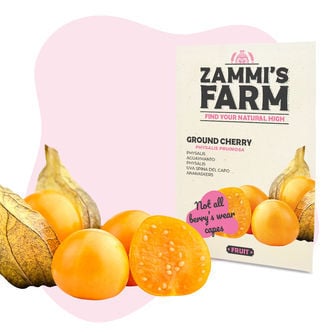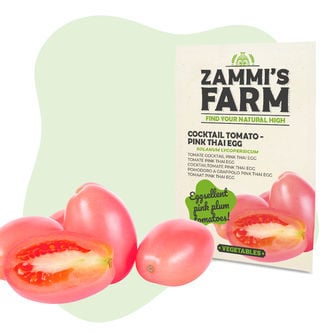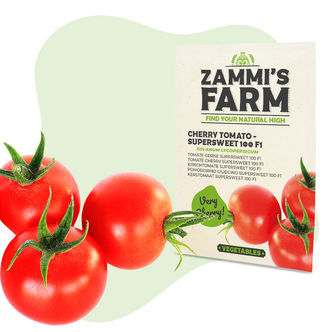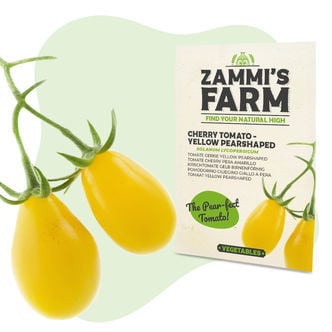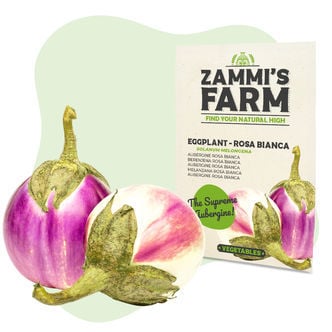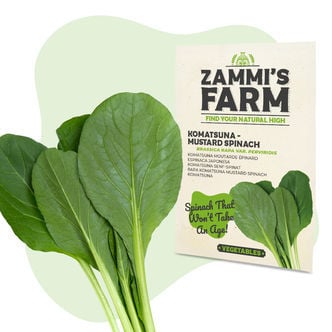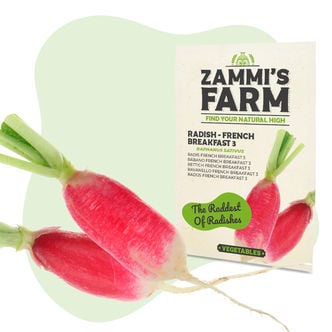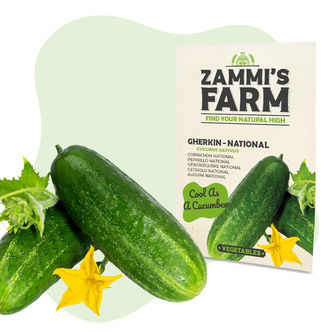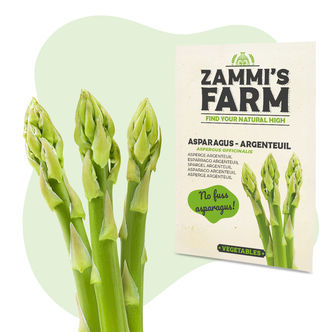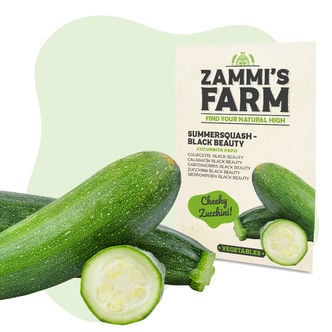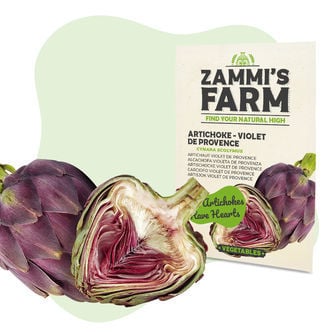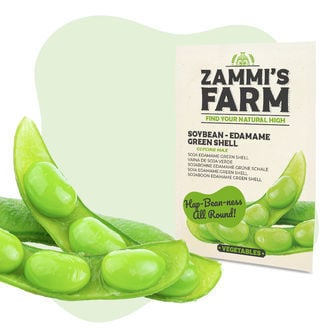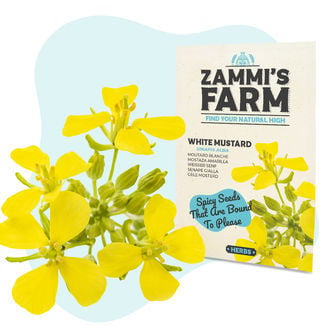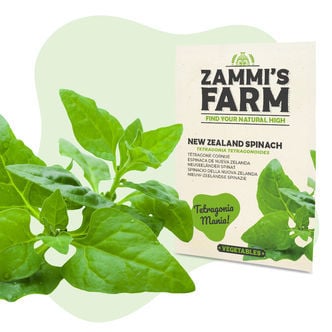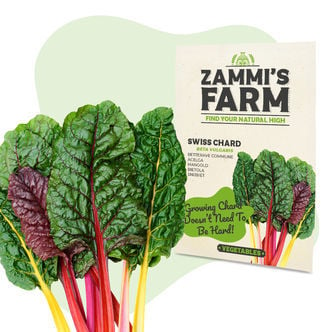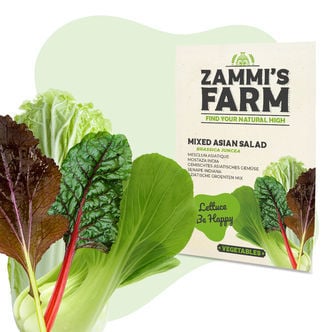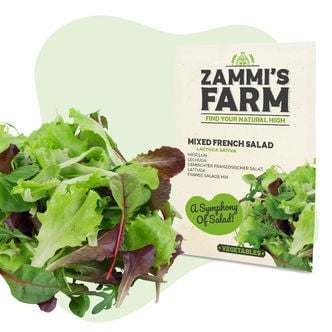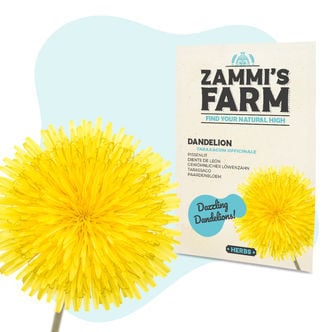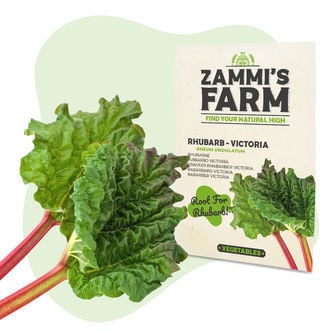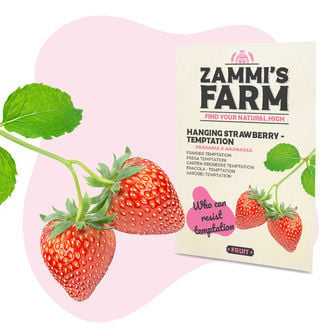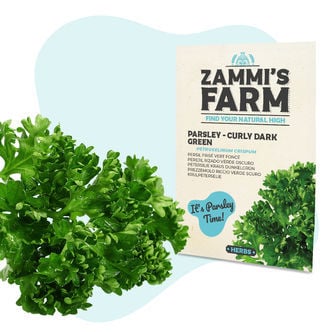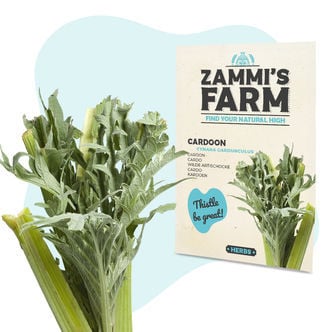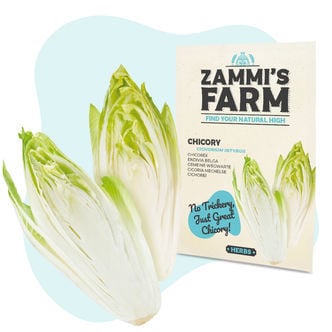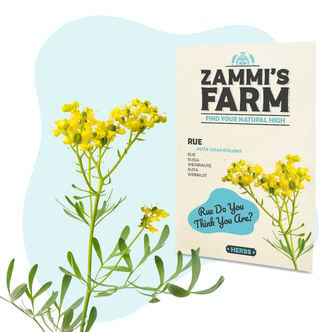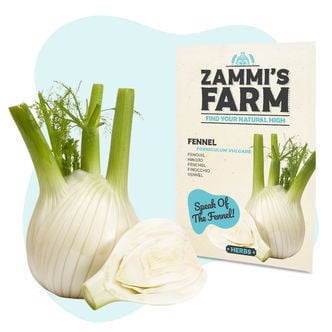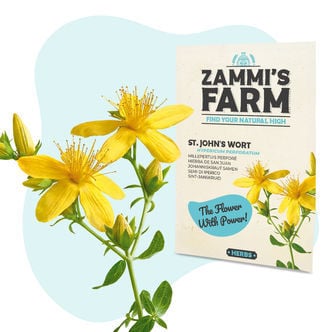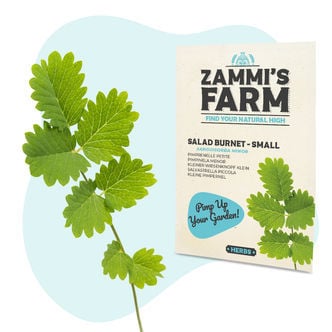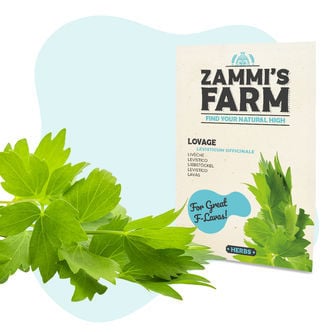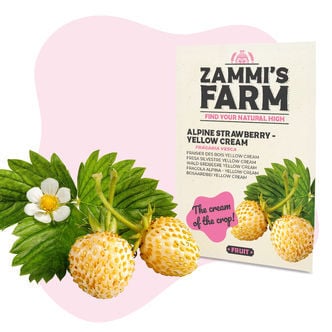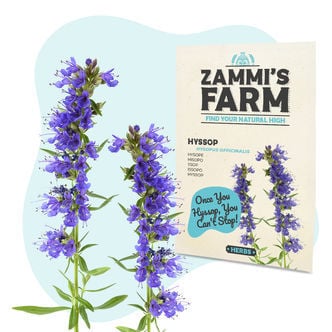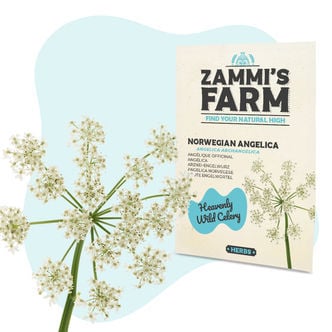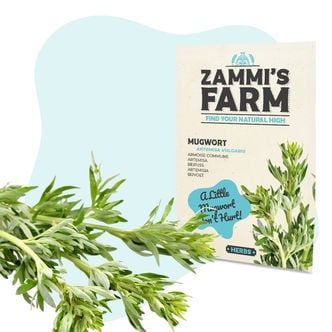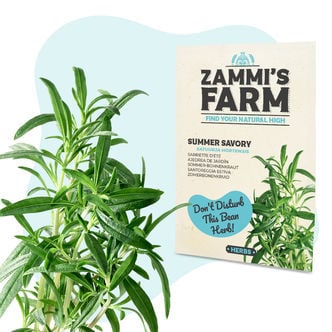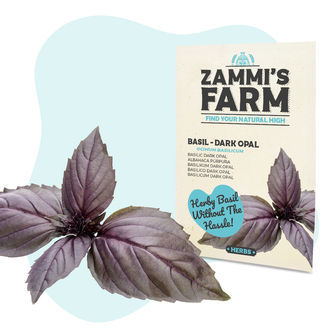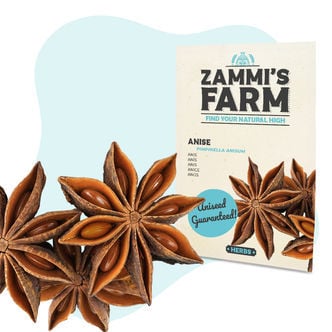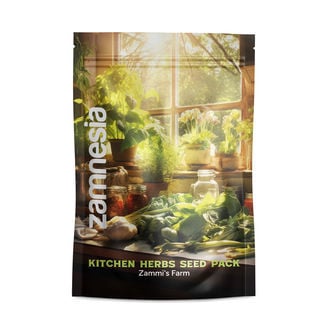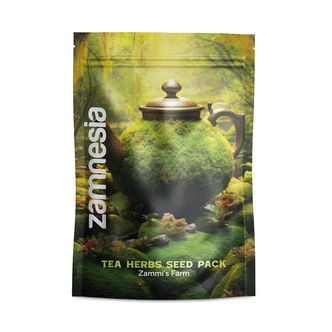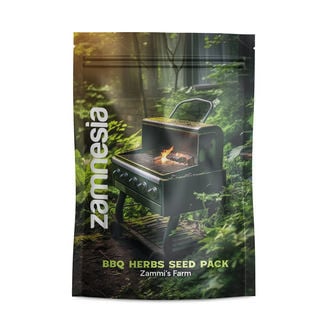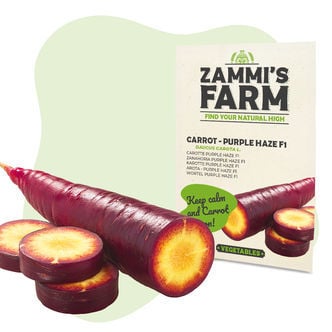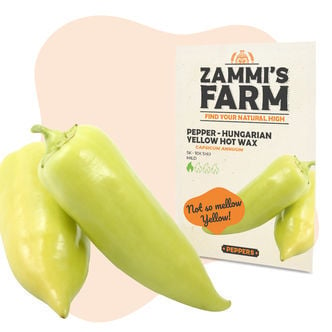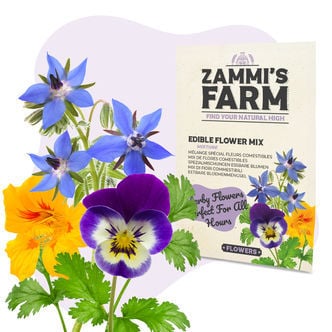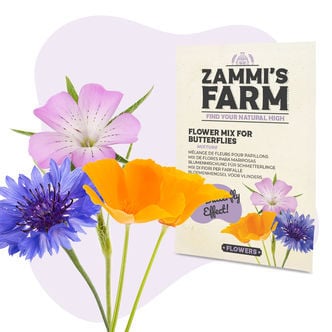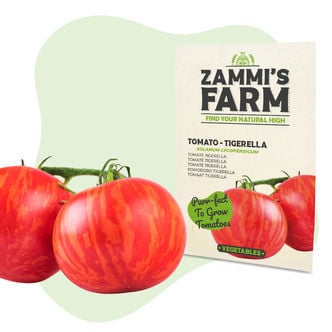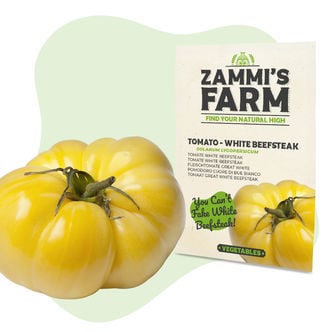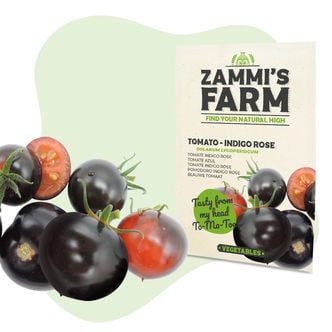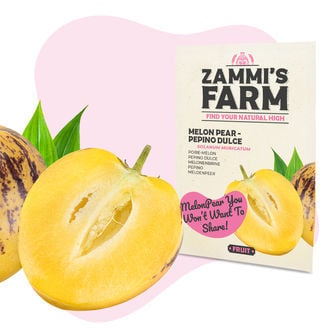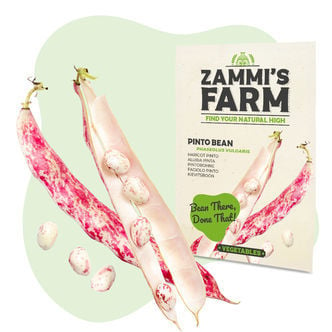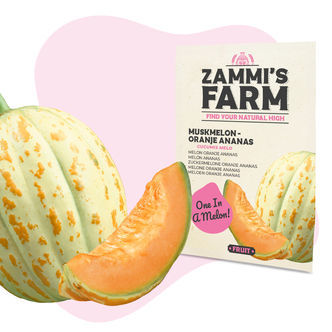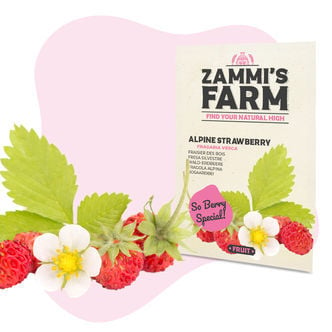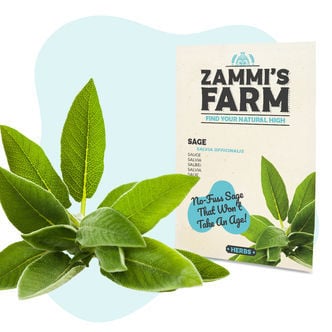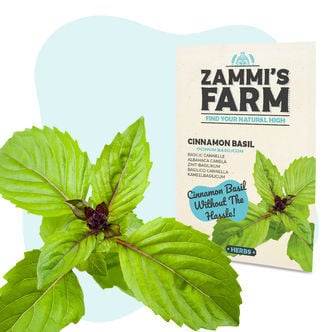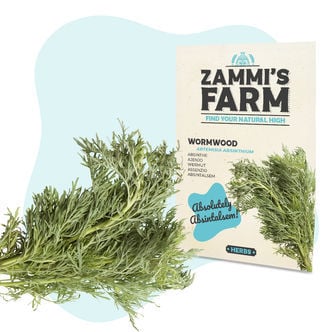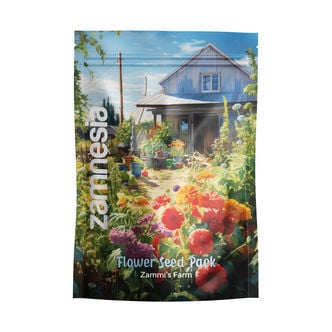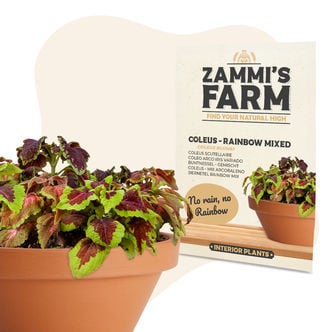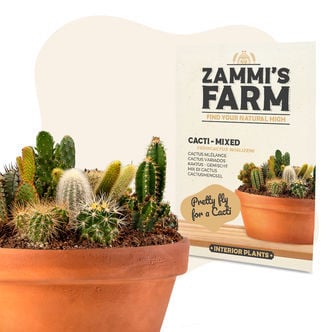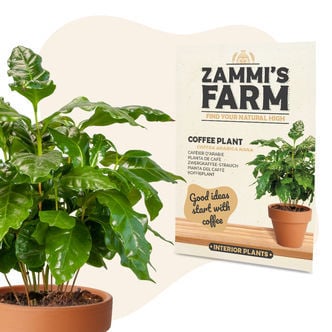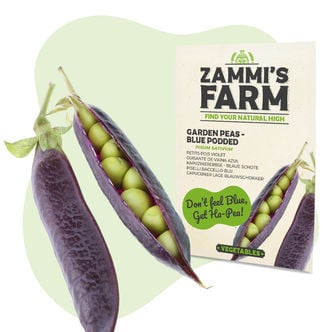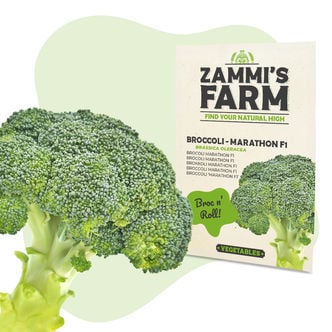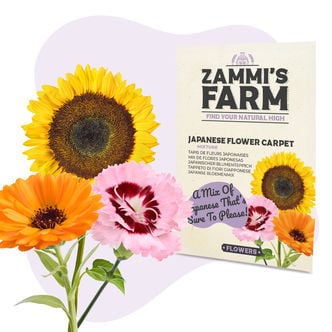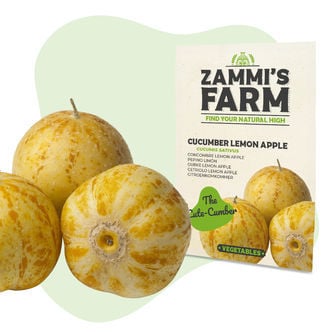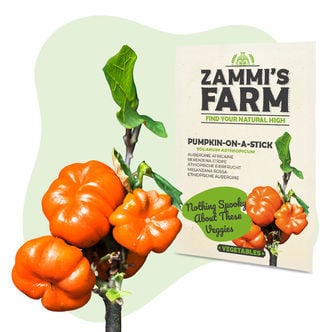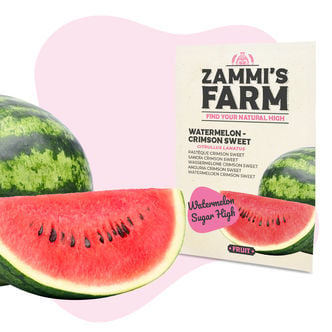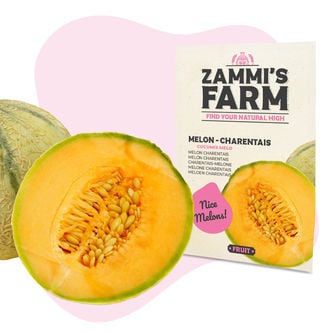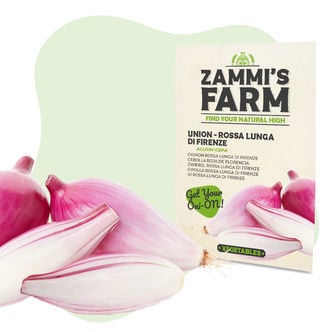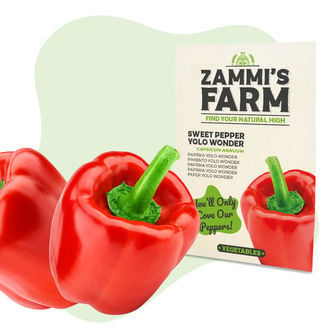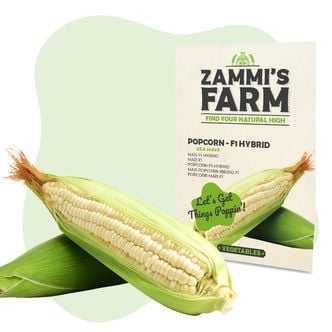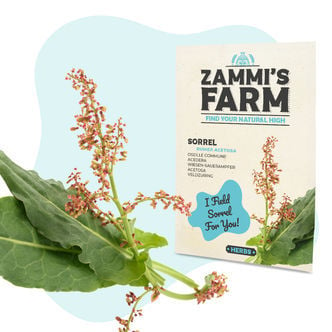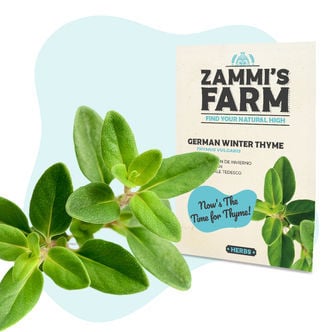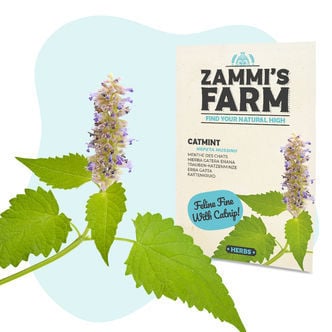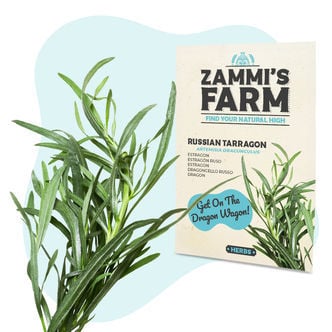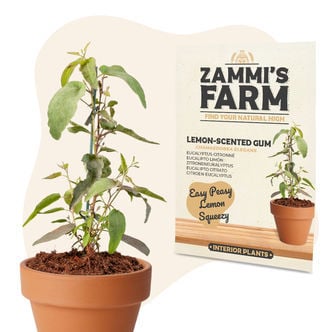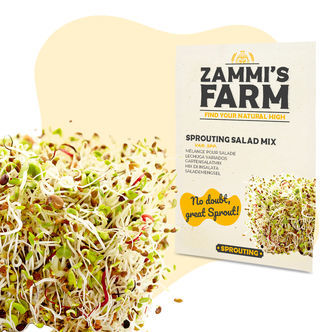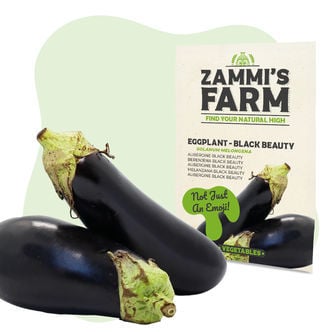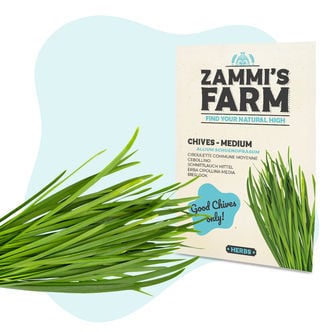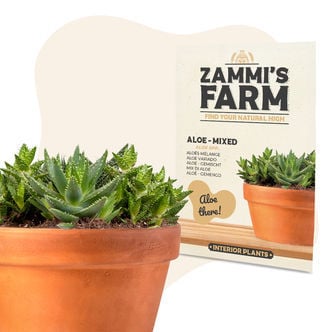All Seeds
There are 207 products.Want to give your garden a boost, but unsure of what to pick up? Have no fear! We've arranged all of our plant seeds in one place! This way, you can see exactly what's on offer, without the risk of missing anything. Whether you're looking to spruce up your growing space with colourful flowers or want to cultivate your own fruits and vegetables, we've got you covered.
With seeds catering for all experience levels and environments, you're sure to find at least one product that meets your needs and preferences. While certain varieties require a more hands-on approach, plenty of others offer a relaxed and easygoing cultivation experience. So, if you're thinking of getting into gardening, or rekindling a passion, let Zamnesia's Plantshop guide you to great plants that will flourish in no time.
Poppy (Papaver somniferum) Seeds
Poppy (Papaver somniferum) is the plant from which opium, morphine, and heroin are made. The poppy seeds themselves don’t contain any alkaloids. With Zamnesia Poppy Seeds, you can grow your own poppy plants at home with ease!
Green Mormon Tea | Ephedra viridis Seeds
Green Mormon tea (Ephedra viridis), also known as green ephedra or Indian tea, is a shrub that grows in dry areas of the Western United States. 20 seeds
Velvet bean | Mucuna pruriens
The Velvet bean (Mucuna pruriens) is a tropical plant that has long been used in many cultures around the world.
California Poppy (Eschscholzia californica) 100 seeds
California poppy makes a stunning addition to many ornamental gardens, earning attention due to its bright and vibrant orange shades.
Peyote (Lophophora williamsii) 20 seeds
With our freshly harvested high quality Lophophora williamsii (Peyote) seeds you can now grow your own Peyote cacti at home. As compared to fully grown Peyote cacti plants, cultivating your own Peyote can be more economic because you can grow them at relatively low cost. Plus, being able to watch your Peyote seeds grow to full-grown flowering plants can make for a fascinating hobby all on its own!
Echinopsis macrogona (Trichocereus macrogonus) 20 seeds
Echinopsis macrogona (AKA Trichocereus macrogonus) is a sacred cactus. Like the Peruvian torch cactus, Echinopsis macrogona contains mescaline which gives it powerful psychedelic and hallucinogenic properties. With the Echinopsis macrogona seeds available at Zamnesia you can now grow this sacred cactus at home!
Trippy Garden Pack - Smart Seeds
This Trippy Garden Pack contains a range of different seeds that will flourish into plants containing legal psychoactive compounds. If a herb garden doesn't quite cut it for you, then these seeds will give you a real project. Experiment with a range of psychoactive plants and see which you like the best.
Peruvian Torch (Echinopsis peruviana) 20 seeds
Echinopsis peruviana, better known as the Peruvian Torch cactus is another of the hallucinogenic cacti that is native to South America. The Peruvian Torch contains the psychoactive alkaloid mescaline which makes for powerful, altered states of consciousness. With our fresh Peruvian Torch (Trichocereus peruvianus) seeds you can now grow this sacred cactus easily at home.
Bolivian Torch (Echinopsis lageniformis) 20 seeds
The Bolivian Torch (Echinopsis lageniformis) is one of the psychedelic cacti of South America that plays an important role in Shamanic rituals. It is similar in appearance to the San Pedro cactus but with fewer and wider ribs. Like the San Pedro cactus, the Bolivian Torch contains a number of psychoactive alkaloids including the powerful psychedelic compound Mescaline.
San Pedro (Echinopsis pachanoi) 20 seeds
Echinopsis pachanoi, the original San Pedro cactus is one of the sacred cacti of South America. For centuries, this cactus has played an important role in Shamanic culture. The cactus is a native to Bolivia and contains psychoactive compounds, the most important one Mescaline. With our fresh Echinopsis pachanoi (San Pedro) seeds you can now easily grow your own San Pedro cacti at home!
Prickly Pack - Mescaline Cacti Seeds
This variety pack of cactus seeds contains everything you need to start cultivating your own mescaline cacti at home! There are numerous species of mescaline-containing cacti, and each one has a slightly different combination of alkaloids, giving each distinct effects. With this pack, you have a range of mescaline cactus seeds to experiment with.
Klip Dagga (Leonotis nepetifolia) Seeds
Native to Africa and Southern India, klip dagga is a colourful plant with a unique appearance. Fortunately, it's also pretty simple to grow. Sow the seeds indoors at the end of April in moist soil, and keep the same conditions until they germinate. Then, move them outside so they can flourish. Provide them with plenty of light and warmth, and harvest leaves and flowers when ready.
Ashwagandha (Withania somnifera) Seeds
Ashwagandha (Withania somnifera) is a shrub native to India, and it has been used for many years in the Ayurvedic tradition. Attractive and easy to cultivate, why not try growing it in your very own garden?
Wild Lettuce (Lactuca virosa) Seeds
Wild lettuce (Lactuca virosa) thrives in cool and cold conditions and produces edible leaves throughout most of the year, even into winter. Plus, it's full of nutrients. Get growing!
Asparagus Fern (Asparagus plumosus Nanus) Seeds
Looking for a beautiful houseplant but don't have a green thumb? The Asparagus Fern (Asparagus plumosus nanus) is a great choice. These plants can be grown indoors all year long at temperatures around 20°C. Ideal for small-to-medium pots and bright rooms without direct sunlight. With long, pinnate leaves, lace ferns are a treat for the eyes yet super easy to care for.
Barley - Cat Grass (Hordeum vulgare) Seeds
Barley - Cat Grass (Hordeum vulgare) Seeds are, as the name suggests, purrfect for your cat. It works as a digestive aid for them and may also prevent hairballs! The plant is effortless to grow and care for and can be sown between the months of April and September. Pick a light spot for them to flourish in, but ensure it doesn't get too much direct sunlight. This is one fast plant to grow!
Pumpkin Uchiki Kuri (Cucurbita maxima) Seeds
Uchiki Kuri, also known as Red Kuri, is a bright orange squash variety. Seeds can be sown in spring outdoors directly in seed beds. Mature plants like rich organic soil, so prepare the soil with compost or manure or fertilize regularly. Besides being very decorative, Uchiki Kuri squash boasts sweet flesh that goes great in sweet and savoury recipes.
Small Ornamental Gourds Seed Mixture
Ornamental gourds are beautiful decorations, ideal for flower arrangements, centrepieces, and more. With this seed mix, you can grow a wide variety of ornamental gourds at home with ease. Simply sow seeds in spring directly in the ground. If need be, you can transplant plants after 5-6 weeks. Remember to slowly dry the harvested fruits for long-lasting, beautiful gourds.
Climbing Flowers Seed Mix
Got a fence or trellis that you want to decorate with some colour? This seed mix contains a wide variety of climbing flowering plants. Sow them between mid and late spring in thin rows directly where you want the flowers to grow. As they grow, gently coax the growth onto/around the trellises/fences in your garden and watch them shine with colour in no time!
Californian Desert Fan Palm (Washingtonia filifera) Seeds
As the name suggests, the Californian Desert Fan Palm is from the far southwestern USA and Mexico, where it grows naturally in, you guessed it, the desert. Indoors, it grows well in sunny, warm spots to small sizes. In summer, feel free to bring your palm outside in the full sun to encourage further growth. Indoors, keep its soil moist and give her as much sun as possible.
Cigar Plant (Cuphea ignea) Seeds
Known as the Mexican Cigar Plant or Firecracker Plant, Cuphea ignea gets its name from its bold, orange, tubular flowers. It makes for a beautiful houseplant indoors, requiring direct sunlight, warm temperatures, and well-draining soil. When growing from seed, separate seedlings when they're roughly 8-10cm tall and plant them in small-to-medium pots.
Neanthe Bella Palm (Chamaedorea elegans) Seeds
Commonly known as the Parlor Palm, Chamaedorea elegans may be native to Central America but has since taken over homes all over the globe. With their deep green foliage, these palms are stunning all year round. Start your seeds when it's warm (25º) in moist seed trays and be patient—Parlor Palm seeds can take up to 100 days to germinate! Parlor Palms like bright spaces away from direct sunlight.
Sensitive Plant (Mimosa pudica) Seeds
Known by many different names, including the Sensitive Plant, Sleepy Plant, and Touch-Me-Not, Mimosa pudica is an annual plant belonging to the pea and legume family. This variety can be grown all year round, and seedlings are best started indoors in spring. Native to central & south America, these plants like warm, sunny, and humid environments and are known for closing their leaves when touched.
Dwarf Pepper 'Mixed' (Capsicum annuum) Seeds
Add some colour to your home! These peppers aren't really suitable to eat due to their acquired taste that isn't super flavourful. But what they lack in flavour, they more than makeup for their outstanding appearance. Simply pot these seeds indoors in February and let them flourish throughout the year as they showcase massively appealing red and yellow colours, brightening any space.
Yellowstone F1 Carrot (Daucus carota) Seeds
Add some bright yellow magic to your garden with these Yellowstone F1 Carrot (Daucus carota) Seeds. Simply sow these seeds directly into the ground in March and keep the soil moist throughout their growing cycle. When August rolls around, you'll be met with a whole bunch of yellow carrots that are perfect for a wide variety of dishes and meals. What could be better than that?
Carrot - Interceptor F1 (Daucus carota) Seeds
These slimline carrots make for a healthy snack and have a sweet, satisfying taste. What's more, is that these seeds are effortless to cultivate and are unlikely to give even the most novice of growers a hard time. Sow these seeds directly into the ground and provide them with a little maintenance and upkeep and they'll deliver a bevvy of bright orange beauties come July-October. Perfect.
Broad Bean Leidse Hangers (Vicia faba) Seeds
Broad beans are not only delicious but also super healthy. This fast-growing and resistant variety can be planted in early spring or fall and produce plentiful harvests of long, sweet beans filled with 5-6 pods. Blanched, stir-fried, or in soups and stews, these delicious beans make a great addition to a variety of meals. Plus, they can also be frozen fresh and keep for months in the freezer.
Kalimero F1 Snack Cucumber (Cucumis sativus) Seeds
Whether pickled, as part of a salad or just a healthy treat, our Kalimero F1 Snack Cucumber is an incredibly simple veg to cultivate, not to mention extremely fast too! Get them going indoors around March and bring them outside for them to flourish over Summer. They're so quick to grow that you can actually get a few harvests from the same plant at the end of Summer. Versatile and accessible!
Cucumber Bella F1 (Cucumis sativus) Seeds
Bella F1 cucumber seeds (Cucumis sativus) produce long, sweet, and crisp fruit and are resistant to mildew. Start seeds outdoors in early-mid Spring and remember to water your plants generously while taking care not to wet their leaves (which attracts moulds and other pathogens). Use trellises to support the long vines and save space, and enjoy continuous harvest all throughout summer.
Telegraph Cucumber (Cucumis sativus) Seeds
There's nothing quite like the refreshing flavours of cucumbers. Whether added to salads or as a snack, Telegraph Cucumber (Cucumis sativus) is one versatile veg. Get these seeds started under glass from mid-March, provide some maintenance and upkeep, and come Summer, you'll have plenty of cucumbers to get your fill of. Leave around 40cm between plants and provide moist soil, and you're golden.
Paprika Purple Bell (Capsicum annuum) Seeds
Add some vibrant violet colours to your garden! Paprika Purple Bell is the way to go. Get these seeds sown and started under glass between March and May, and you'll be greeted with a bevvy of purple peppers come summertime. Just house them in moist soil with a consistent temperature of around 20-25°C; you can't go wrong. With sweet flavours, they make the perfect addition to all kinds of dishes.
Sweet Pointed Pepper Palladio F1 (Capsicum annuum) Seeds
Get these bright yellow beauties going from mid-March, and give them plenty of light, sun and moist soil, and they'll flawlessly perform. These sweet and mild peppers will be ready come late Summer. They require very little in the way of maintenance and are extremely versatile. Whether you add them to salad, tacos or any other savoury dish, these yellow peppers are sure to brighten your plate.
Sweet Pointed Pepper Kapiya (Capsicum annuum) Seeds
Looking for something genuinely vibrant both in colour and flavour? Allow us to introduce the Sweet Pointed Pepper Kapiya. It's believed this pepper is originally from Bulgaria but has been used widely throughout Europe and the rest of the world. Sow these seeds in early Spring and repot as soon as the first leaves appear. Move the plants outside and let them flourish until October.
Onion de Paris (Allium cepa) Seeds
How do you get your hands on some great-tasting onions? Easy, simply sow these seeds in early Spring under glass and then move them outside in late April. This will give them plenty of time over the summer to mature and be ready for the picking! These onions are perfect for pickling or including as tiny veg on your plate or as part of a summer salad. The options are plentiful, and so is the yield!
Microgreens Fennel (Foeniculum vulgare) Seeds
Peppery, mild and sweet, Microgreens Fennel takes just 7-14 days to germinate and just another 2 weeks on top until the earliest greens are ready to harvest and use in a multitude of dishes. Just provide them with plenty of light and warmth and keep the surrounding soil moist, and you simply can't go wrong! This is one fast-to-grow plant that delivers in all areas. Get some in your home today!
Microgreens Salad Mix (Lactuca sativa) Seeds
With a selection of great greens available here, the vibrant Microgreens Salad Mix is ideal for adding to salads and can actually be grown all year round. Quick to flourish, sow the seeds when it works for you; just be sure to keep the soil moist but not waterlogged, and this plant will deliver delicious, moreish leaves and work perfectly in plenty of dishes. Ideal for all growers!
Microgreens Exotic Salad Mix - Seeds
Take your salad game to the new level with Exotic Salad Mix. It's really easy, just scatter the seeds on top of the soil and press gently. Cover with a thin layer of soil and spray with water. Use the mister once or twice a day to keep soil most. Harvest after 2–3 weeks, when you see the first set of true leaves. Microgreens thrive in sunny environments, think windowsills or balconies.
Microgreens Kale (Brassica oleracea) Seeds
Kale (Brassica oleracea) is in the spotlight for being one of the most nutritious greens on the market. But did you know that kale sprouts are even more packed with nutrients than fully mature kale plants? Sow kale seeds in a propagator at high density, and harvest your sprouts after 7–10 days for a fresh, delicious, and highly nutritious microgreen.
Microgreens Radish - Daikon Green (Raphanus sativus) Seeds
Green Daikon Radish is delicious and highly nutritious, used typically as a garnish in Japanese cuisine. Daikon Green Microgreens, however, are just as packed with flavor yet with much higher nutrient density. To grow them, simply sow seeds at a high density in a propagator and harvest the sprouts after roughly 1 week. With a fresh, tangy flavour, they go great in fresh and cooked Asian dishes.
Wildflowers Seed Mixture
Upgrade your garden with this fine selection of wildflower seeds. This mixture of both annual and perennial flowers means that your garden is completely cared for, for the entirety of the year and well beyond. All varieties have been carefully chosen to provide the finest colours and aromas that are eye-catching not only to humans but also butterflies, bees and a host of other insects.
Rocket Sprouts (Eruca sativa) Seeds
The peppery leaves of Rocket Sprouts make for the ideal addition to a wide variety of dishes; what's more, is that the path to this tasty produce is an extremely easy one, regardless of your prior expertise! Rocket Sprouts can be grown in indoor, outside, and greenhouse settings and require very little in the way of maintenance. Sow seeds in early Spring and enjoy great flavours come Summer.
Nasturtium 'Single Flowered' (Tropaeolum majus) Seeds
Boasting deep red, orange, and yellow hues, nasturtium flowers are surrounded by rich green leaves, making for a visually appealing plant. Able to reach heights of around 3m, this climbing plant is ideal for walled gardens and spacious areas. Not only boasting great looks, the flowers are also edible, making a vibrant addition to various dishes.
Cornflower 'Blue Ball' (Centaurea cyanus) Seeds
The Blue Ball cornflower is a great-looking flower that's ideal for a whole host of gardening set-ups. Sow the seeds directly into the ground in a place of your choosing in late spring, and they'll mostly take care of themselves throughout the summer. Without much needed in the way of maintenance, these flowers undoubtedly appeal to all levels of expertise. Colourful and vibrant, perfect for all.
Corn Poppy 'Single Red' (Papaver rhoeas) Seeds
Add some colour to your garden with these bright red poppies. Sow seeds in late spring and watch them flourish. Come June–September, you'll be met with beautiful deep red hues. Low-maintenance and accessible to all levels, just give them plenty of light, warmth, and water.
Organic Flower Seed Mix for Bees
Give both yourself and the bees a treat with our Organic Flower Mix for Bees. This seed mix contains nectar-centralised species of flowers that are irresistible to bees. Not only serving for pollination, but the flowers are also great looking and aromatic too. Bound to spruce up any garden space effortlessly. Sow them in April and allow the plants to flourish all summer. It really is that easy.
Alyssum (Lobularia maritima) Seeds
Otherwise known as Sweet Alison, alyssum is an all-white flower that's suitable for all gardens. Whether positioned in flower beds, rockeries or pots, allow alyssum to provide some subtle beauty to your garden. Sow them in early April under glass and then fully transplant them roughly 5–6 weeks later. Once outdoors, they'll flourish in the sunlight and warmth for the summer. Loved by bees.
Broccoli Sprouts (Brassica oleracea) Seeds
Whether you like them in your smoothie, salad or sandwich, there's no denying the rich antioxidants and tasty flavours of Broccoli Sprouts. They're also incredibly simple to cultivate. Sow the seeds in a pot in early Spring and give them plenty of sun, warmth and a little water now and again, and they'll flourish effortlessly. Come August, they'll be ready to harvest and can be enjoyed instantly.
Cress Sprouts (Lepidium sativum) Seeds
Cress Sprouts make for an easygoing and hugely rewarding growing project. Whether situated on a windowsill or as part of your garden, it'll perform with very little maintenance required. This is a fast-growing plant that can be sown and grown all year round. Just be sure to provide temperatures of around 20-22°C and a little upkeep, and you can enjoy tasty cress rich in vitamins A, B and C.
Summer Flowers Seed Mixture
The Summer Flowers Mixture features a wide variety of flower seeds that will brighten up any garden you place them in. Sow them in early April, and by the time summer rolls around, your garden will be hugely colourful, vibrant and aromatic. Once fully grown, you can marvel at your handiwork and enjoy the fruits of your labour. With little upkeep required, they are ideal for all—including bees!
Forget-me-not 'Indigo Blue' (Myosotis alpestris) Seeds
A truly unforgettable flower, the forget-me-not, otherwise known as Myosotis alpestris, is a plant that's native to Europe and is a vibrant blue flower that's suitable for any garden. Sow them in open ground in July and let them flourish in a shady spot. Keep the ground moist throughout the growing cycle, and you'll be rewarded with a bevvy of beautiful flowers to brighten up your garden or home.
Cornflower 'Mixed' (Centaurea cyanus) Seeds
With an abundance of purple, blue, pink, and white hues, the cornflower (Centaurea cyanus) is one of the best options for brightening up your garden. Pleasing to the eye but overall undemanding, these plants will appeal to gardeners of all skill levels. Whether planted in borders or as wildflowers, these flowers will attract bees and other beneficial insects to your garden.
Alfalfa Sprouts (Medicago sativa) Seeds
It takes about 5 days to grow alfalfa sprouts. Use a sprouting jar, soak the seeds in cool water for 8–10 hours, drain well. Spread seeds out in the jar and leave for 10 hours at room temperature, away from direct light. Repeat the rinse/dry process until sprouts reach preferred size. Alternatively, place sprouts between damp paper towels after soaking. Add to salads, sandwiches, or stir-fries.
Scented Garden Flower Mix
Consisting of 15 flower varieties, this mix of seeds provides the perfect way to add fragrant aromas and a bevy of beautiful colours to your garden. Effortless to grow and resilient, simply sow your seeds in a place of your choosing, provide sufficient water, sun, and warmth, and they'll flourish with the greatest of ease. Thanks to their great aromas, insects will do the work of pollination.
Pumpkin Jack O' Lantern (Cucurbita pepo) Seeds
Bred especially to be carved into Jack O' Lanterns, this beautiful orange, oblong Cucurbita pepo variety produces pumpkins that are very decorative yet still tasty, too. Sow your Jack O' Lantern seeds indoors in late winter, or directly outside in early spring. Like other pumpkin varieties, Jack O' Lanterns are best grown in fertile soil with stakes or trellises to accommodate their long vines.
Tomatillo (Physalis ixocarpa) Seeds
The Tomatillo or Mexican Husk Tomato dates back to the pre-Columbian era. It produces a spherical fruit with a green/purplish colour that looks similar to tomatoes but has a different flavour and texture. Tomatillo seeds are best sown indoors, and plants can be brought outside in Spring after the last frost. Tomatillo plants like well-draining soil, full sun, and regular organic fertilisation.
Bitter Gourd (Momordica charantia) Seeds
The bitter gourd, otherwise known as bitter melon or balsam pear, is a fruit that originally comes from Africa and Asia. However, now you can grow it right at home! Start it off in a greenhouse or indoors for 4 weeks, then move it outdoors to flourish in the summer months. Typically, it'll be ready to harvest come October. Pair it with fish or meat, and you simply can't go wrong.
Horned Melon (Cucumis metuliferus) Seeds
Looks can be deceiving with this prickly fruit. It might look a little intimidating, but it's what's inside that counts. The Kiwano houses a sweet taste that's reminiscent of lemons and bananas. Perfect for fruit salads and desserts. Start your plants out in a greenhouse and then place them outside for full sun. A little hands-on grow-wise but manageable, it needs a warm climate or location.
Garlic Chives (Allium tuberosum) Seeds
Also referred to as Chinese chives and oriental garlic, garlic chives are a tasty herb with flavours reminiscent of its namesake. It's used in a wide variety of dishes, such as fish, salads, and soups. Before using them, though, you'll need to grow them! An easy affair, you can grow garlic chives both indoors and outdoors. Just give them moist soil and regular light, and watch them thrive.
Mallow (Malva sylvestris) Seeds
The mallow, or Malva sylvestris as it's otherwise known, is a plant that's commonly found in the warmer climes of Iran and North Africa. However, now you can grow this colourful companion at home. Sow these seeds in April, and you'll see that come September, you'll have some fully formed flowers at your disposal. Mallow is a particular favourite for use in soups.
Atlantic Giant Pumpkin (Cucurbita maxima) Seeds
Try your hand at growing Atlantic Giant Pumpkin which can weigh 100kg and more. This vegetable thrives in warm and sunny spots, and you can sow your seeds indoors in mid-spring or early summer outdoors. Ensure your plants have fertile soil and are sheltered from cold winds and you will be able to sit back and watch this vigorous grower. Harvest in September/October, right for Halloween!
Winter Squash Sweet Dumpling (Cucurbita pepo) Seeds
Sweet Dumpling is a delicious variety of winter squash (Cucurbita pepo) with a hard, cream-coloured rind and tender, sweet flesh. Growing to roughly the size of a grapefruit, Sweet Dumpling squash make a great addition to any veggie patch. Start seedlings off indoor in late winter or directly outdoors in early spring. Like other squashes, plant Sweet Dumpling squash in highly fertile soil.
Valerian (Valeriana officinalis) Seeds
Valerian is a hardy plant that thrives in full sun and half-shade in almost all soils. Plant in an outdoor seedbed around April-May, prick out once in June, before transplanting them in autumn to their final position in your garden. The extracted juices of valerian root can be used for making home concoctions, while its leaves make for great additions to salads.
Winter Squash Baby Bear (Cucurbita maxima) Seeds
Baby Bear Winter Squash (Cucurbita maxima) is a must-have for every veggie patch. Germinate your seeds indoors and bring them outside in the spring. Plant Baby Bear squash in soil with plenty of manure or compost to ensure healthy growth and the production of large, sweet fruit. Use tutors, stakes, or trellises to grow Baby Bear Squash vertically in smaller spaces.
Stevia (Stevia rebaudiana) Seeds
Stevia rebaudiana or sugarleaf is very easy to grow. Germinate seeds indoors and bring them outside in mid-summer. Plant stevia in full sun in well-draining soil with a pH of 6.7-7.2. Feed plants regularly with a natural liquid fertilizer or nitrogen-rich organic fertilizers like compost, worm castings, guano, or something similar to fuel healthy leaf growth. Use stevia as a natural sweetener.
Purple Perilla (Perilla frutescens) Seeds
Perilla, shiso, or deulkkae (Perilla frutescens) is an annual plant native to Southeast Asia and India, and is often used as a garnish for fish, rice, and tempura dishes. Perilla likes sunny or part-shade locations and deep, wide, well-draining plots of soil to accommodate its low, outward growth. Harvest mature perilla leaves and use them as an aromatic in your favorite dishes or infusions.
Ground Cherry (Physalis peruviana) Seeds
Also known as the Cape gooseberry, Ph. peruviana is native to Chile and Peru, where it is commonly called aguaymanto, uvilla, or uchuva. A member of the Nightshade family, the Ground Cherry produces sweet fruits in a papery husk. Propagate these seeds indoors in early spring, then bring plants outside in early summer. Their fruit is ripe once it falls from the plant and can be eaten raw.
Cocktail Tomato 'Thai Pink Egg' (Solanum lycopersicum) Seeds
Thai Pink Egg Tomatoes originate from Thailand where they're treasured for their bright colour and deliciously sweet flesh. While they grow very similarly to other tomato (Solanum lycopersicum) varieties, Thai Pink Egg tomatoes like a little more water than usual, and hold up better in rainy climates as well as heat waves. Remember to prune and fertilize tomatoes regularly for bountiful harvests.
Cherry Tomato 'Supersweet 100 F1' (Solanum lycopersicum) Seeds
The Supersweet 100 cherry tomato hybrid is one of those plant hybrids that says it all in its name: these plants produce extremely sweet fruit and, in the right conditions, can grow into long vines capable of producing 100 or more tomatoes at once. Note that this is a tall tomato variety that needs full sun, support from stakes/trellises, plenty of care, and a lot of natural fertilizer to thrive.
Yellow Pear Cherry Tomato (Solanum lycopersicum) Seeds
Besides their vibrant yellow colour, Yellow Pear Cherry Tomatoes (Solanum lycopersicum) boast a deliciously sweet, slightly acidic flavour. Sow your seeds in spring after the last frost and enjoy an endless supply of sweet cherry tomatoes all through summer. Yellow Pear tomatoes grow best in full sun and fertile soil. Fertilise plants regularly and use stakes or trellises to support their vines.
Eggplant 'Rosa Bianca' (Solanum melongena) Seeds
The Rosa Bianca eggplant variety (Solanum melongena) produces large, globe-shaped white fruit with beautiful lavender-purple streaks. Like other eggplant varieties, Rosa Bianca grows best in warm conditions and full sun. It likes fertile, moist, and acidic soil, occasional watering, and a hearty dose of phosphorus during flowering. Remember to mist plants regularly as soon as flowers appear.
Komatsuna (Brassica rapa var. perviridis) Seeds
Komatsuna is a unique variety of Mustard Spinach (Brassica rapa), also known as Japanese Mustard Spinach. Like other spinach varieties and leafy greens, Komatsuna seeds are best sown outdoors in nitrogen-rich, moisture-retentive soil. Mulching is recommended to help the soil retain more moisture. Seeds can be sown from early spring to autumn. Harvested leaves can be eaten fresh or cooked.
Cherry Tomato - Cerise (Lycopersicon esculentum) Seeds
Who doesn't love nice, fresh cherry tomatoes to enjoy? No matter the weather, you can have a bevy of bright-red beauties in next to no time. Sow seeds in early spring indoors or outside (if living in a warm climate), and they'll be ready come late summer. Give them moist soil and plenty of light and warmth, and you'll be rewarded with a great yield. Perfect for salads and all kinds of cooking.
Radish 'French Breakfast 3' (Raphanus sativus) Seeds
Crisp and crunchy are just words to describe the French Breakfast 3 variety of radish. They offer up a great "snap" when eaten and have a fresh flavour that's perfect for blending with other vegetables. In fact, it's even recommended that these seeds are sown next to carrots or lettuce to give them a good biological balance. Begin them in March, and they'll be good later in the summer.
Gherkin 'National' (Cucumis sativus) Seeds
Grow these gherkins in your garden and you'll have a fine selection of small fruits to pick from. Get them going in early April indoors or in a greenhouse, and then take them outside to plant in May. Provide them with shelter and sun, and you'll have a harvest of gherkins-goodness in no time. Perfect for pickling, they will add some flair and flavour to your food.
Asparagus 'Argenteuil' (Aspergus officinalis) Seeds
Asparagus plants might take time to get to harvest, but they are well worth the wait. Plant asparagus seeds in rows directly in nursery seed beds 4 weeks before the Ice Saints in sandy soil. Seeds can take 3 weeks to germinate, and young plants should be kept in nurseries for 1 year before moving them to their final spot. Transplant mature plant crowns into trenches, adding soil regularly.
Summer Squash 'Black Beauty' (Cucurbita pepo) Seeds
Whether you know it as courgette or summer squash, this adaptable vegetable lends itself well to all kinds of cuisines. Able to produce a huge harvest, make the most of your plants by starting them under glass, and then move them outside to flourish in the summer months. Give them the perfect balance of sunlight, warmth, and shade, and you'll be rewarded with plenty of delicious veggies.
Artichoke 'Violet de Provence' (Cynara Scolymus) Seeds
Not only mindblowing in the flavour department, but Violet de Provence artichokes also showcase amazing looks that make it a must for any garden. Sow the seeds indoors between February and April, and place them outside in early summer. This is a perennial plant that will just keep going as long as you need it. Easy to care for, just cover in the winter months, and it'll usually look after itself.
Soybean 'Edamame Green Shell' (Glycine max) Seeds
Perfect in Asian cuisines and as a healthy snack, edamame has plenty of uses. You'll be pleased to know that it's also pretty easy to cultivate from home too! Get plants started indoors or in a greenhouse in early May, and then once the seedlings are big enough, move them outdoors to soak up the sunlight and warmth. Come October, you'll have a bevy of soybeans ready to go.
White Mustard (Sinapis alba) Seeds
White mustard (Sinapis alba) is versatile. Use the seeds in cooking, sauce making and pickling, and the young leaves in salads and other dishes. The choice is entirely up to you. If you're looking to grow, sow the seeds in March, and they'll be ready in the summer. Generally low maintenance, all it takes is just some moist soil and the standard light and warmth, and you'll be golden.
New Zealand Spinach (Tetragonia tetragonoides) Seeds
New Zealand spinach can be harvested over a long period, which makes it ideal for continual use in cooking once ready. Be sure to soak the seeds in a bowl of water overnight before sowing to make sure they germinate. Able to be sown inside in early April or plant outdoors in May-August. Provide warmth and sun and come November time, you'll be ready to enjoy all New Zealand spinach has to offer.
Red Swiss Chard (Beta vulgaris) Seeds
A robust year-round plant, Red Swiss Chard, otherwise known as Beta vulgaris, is a plant that can sprout rhubarb-like stems with leaves that can all be utilised in plenty of different culinary dishes. With a sowing period of March until July, enjoy the fruits of your labour come September/October time. With bright red colouring, this will brighten up both your garden and dinner plate.
Mixed Asian Greens Seeds
Get your seeds sown in early March, and by the end of August, the young leaves of the greens will be ready to harvest. A versatile combination of pak choi, taisai, tatsoi, turnip greens, chard, Chinese cabbage, leaf mustard and purple frills. All of these combine great flavours in a variety of dishes. Just be sure to provide plenty of light, warmth and moist loamy soil for best results.
Mixed French Salad (Lactuca sativa) Seeds
Perfect for a light summer meal, Mixed French Salad seeds grow into a mixture of red oak leaf lettuce, endive, radicchio, frisée, and arugula. Great for salads and undeniably tasty. Sow around May, and plants will be ready come September. Grow in moist, loamy soil with plenty of light and warmth for the best results. Reaching small heights, plants are easy to manage and care for.
Dandelion (Taraxacum officinale) Seeds
Taraxacum officinale, aka the dandelion, is a herbaceous perennial plant that's perfect for all kinds of growing setups. Allow the beautiful yellow colour to brighten up your life. Sow in spring, and allow plants to flourish over the summer months. Provide well-draining soil and plenty of light and warmth, and you'll be rewarded with a plant boasting numerous culinary and herbal uses.
Victoria Rhubarb (Rheum undulatum) Seeds
Victoria rhubarb (Rheum undulatum) likes sunny locations and needs exceptionally well-draining soil (waterlogging or overwatering can greatly impact the growth of rhubarb plants or cause them to rot). Rhubarb also doesn't like extremely hot conditions, which can stunt it or stop plant growth altogether. Fertilise in spring and summer for improved growth. Harvest a few stalks at a time in autumn.
Hanging Strawberries (Fragaria x ananassa) Seeds
Fragaria x ananassa is a variety of strawberry that produces long tendrils and beautiful cascades of red, fragrant fruit. Plant seeds in hanging baskets, raised beds, or boxes in fertile soil, and position in a sunny spot. Press seeds slightly with your hand into the soil. Keep plants well-watered, soaking the ground thoroughly every 2–3 days, taking rainfall and temperature into consideration.
Parsley 'Curly Dark Green' (Petroselinum crispum) Seeds
Unlike most herbs, Petroselinum crispum (parsley) likes fertile soil. Parsley plants can be started indoors in a propagator or on a warm, sunny windowsill. Alternatively, sow directly outdoors after the last frost. Parsley plants like full sun, regular watering, and occasional, balanced fertilisation. Harvest fresh leaves and stems to promote bushier growth, and use in the kitchen as you please.
Cardoon (Cynara cardunculus) Seeds
Cynara cardunculus (cardy, cardoon, or artichoke thistle) is a very hardy and somewhat invasive plant. It grows best in soil rich in organic matter (including dung and decomposing plant matter) and in locations with warm conditions and full sunlight. The spiked flowers can be eaten like artichokes, while the stalks are best protected from the sun (using dirt mounds) and served boiled or braised.
Chicory (Cichorium intybus) Seeds
Sow chicory seeds in spring, after the last frost, in a spot with at least 6hrs of direct sunlight. Take care not to bury the seeds deeper than 0.5cm beneath the soil. Seedlings will sprout after 2–3 weeks in moist (but not wet) soil and should be thinned to leave roughly 30cm between plants. Harvest fresh leaves and blanched buds to eat raw. Dried, ground chicory roots can substitute coffee.
Rue (Ruta graveolens) Seeds
Ruta graveolens, or simply rue, is very hardy and can tolerate poor soil fertility and droughts. Plant established rue specimens in full sun and water sparingly, especially in dense soils. Use mulch to insulate rue plants during winter, and cut back plants entirely to their old wood in spring to encourage new growth. While previously used in various cuisines, rue is best grown as an ornamental.
Fennel 'Fino' (Foeniculum vulgare) Seeds
With its unique flavour and aroma, fennel has been a prized vegetable since the days of ancient Greece. Sow in the early spring months, and let the plant flourish until late September before harvesting. Plenty of room is required, as fennel can reach heights of around 2m. Once ready to harvest, fennel root and fronds can be put to versatile use in the kitchen.
St. John's Wort (Hypericum perforatum) Seeds
Hypericum perforatum, or St. John's wort, is an easy-to-grow perennial with beautiful star-shaped flowers. It grows best in full sun or partial shade, and can tolerate loamy or sandy soils, drought, and even flooding. Plant outdoors from early to mid-summer, and propagate St. John's wort from seed, division, or by taking soft-wood cuttings. Harvested flowers have a long history of holistic use.
Salad Burnet (Sanguisorba minor) Seeds
Salad burnet thrives in well-draining soil and is a hardy and robust plant whose leaves will be ready to harvest in late summer. Provide ample light, warmth, and water, and it'll reach heights of around 60cm. A plant favoured by such figures as Francis Bacon and Thomas Jefferson, it has a flavour that's perfect for sauces, dressings, and even summer drinks.
Lovage (Levisticum officinale) Seeds
Lovage seeds are best germinated indoors during spring, then brought outside once they have developed 2 sets of leaves and the last frost has passed. Transplant seedlings into fertile, deep, well-draining soil in full sun. Where possible, keep the soil slightly acidic (roughly 6.5 pH) and partly sandy/loamy with plenty of organic matter. Cook lovage leaves/roots or eat them raw in salads.
Alpine Strawberry - Yellow Cream (Fragaria vesca) Seeds
Easy to look after, Alpine Strawberry prefers sunny balconies, windowsills or garden beds. Germinate indoors. Scatter your seeds on the surface of the soil as they need light. Lightly cover with soil and keep moist with a spray bottle. Seeds need 3–4 weeks to sprout and once they have 4 leaves, they can be transplanted into rich soil and placed outside. Expect fruit same or following year.
Hyssop (Hyssopus officinalis) Seeds
Hyssop, or Hyssopus officinalis, is part of the mint family and traditionally found in southern Europe and the Middle East. This shrub is quick to grow and needs to be sown in moist soil under full sun in the early summer months of June onward. With harvests as early as August, the flowers and leaves of this plant have a range of culinary and holistic uses worth exploring.
Norwegian Angelica (Angelica archangelica) Seeds
Norwegian angelica is a plant that originates from the Scandinavian region of Northern Europe. Producing edible stems that are similar to celery, it has plenty of uses in cooking, and the roots can even be used in gin distillation. Norwegian angelica requires consistently moist soil to flourish. Plant in spring, and it'll be ready to harvest come autumn.
Mugwort (Artemisa vulgaris) Seeds
Artemisa vulgaris likes warm, sunny spots with well-draining, dry soil. Mugwort is a hardy, drought-tolerant plant that grows well in slightly shaded areas and in both acidic and slightly alkaline soil. Mugwort seeds are best germinated in a propagator or outdoors in spring after the risk of frost passes. Fresh mugwort can be used to season stocks, broth, and game, and as a herbal tonic.
Summer Savory (Satureja hortensis)
Summer savory (Satureja hortensis) belongs to the mint family and is a close relative of thyme and rosemary. It grows well in light, loamy soil with good drainage and plenty of sunlight. Leaves can be harvested as soon as plants reach 12.5–15cm tall, and are best consumed before the plants flower for a sweeter flavour. Summer savory makes a great seasoning for dressings, sauces, stews, and pies.
Basil 'Dark Opal' (Ocimum basilicum) Seeds
Like normal basil, Dark Opal basil is best sown indoors. Keep your seedlings on a warm windowsill as they develop their roots and first leaves, then bring them outside in mid/late spring. Like most herbs, basil likes well-draining soil and partial shade/full sun, and is best watered sparingly (in the morning to give the roots time to dry). Use in a variety of cuisines and as a natural insecticide.
Anise (Pimpinella anisum) Seeds
Anise is best sown in early–mid spring in a sunny but sheltered spot. Germination can take between 3–4 weeks, but may be sped up by soaking seeds in water for a few days prior to planting. Pimpinella anisum hates cold and wet conditions, and likes well-draining, slightly acidic soil. Anise seeds can be harvested in late summer/early autumn and used in a variety of sweet and savoury dishes.
Kitchen Herbs Seed Pack - Zammi's Farm
Have a selection of practical and tasty herbs at your disposal with the Kitchen Herbs Seed Pack from Zamnesia. This curated selection of high-quality herbs is perfect for adding to a variety of dishes, and for using as a garnish on your plate too. These herbs are effortless to grow and can be cultivated on a kitchen windowsill for convenient placement when the time comes to use them.
Tea Herbs Seed Pack - Zammi's Farm
This selection of seeds has everything you need to make high-quality herbal tea from home. These plants are easy to grow and maintain, and after just a short cultivation cycle, you'll have access to a variety of herbs you can brew into delicious teas. With a host of potential wellness benefits, this finely tuned and carefully curated selection of seeds shouldn't be missed.
BBQ Herbs Seed Pack - Zammi's Farm
Prepare for BBQ season in the best way possible by growing your very own selection of herbs and plants. Whether you're making side dishes or looking to create rubs, marinades, or sauces, nothing's better than using ingredients you've grown yourself. The BBQ Herbs Seed Pack contains everything you need to make not only the BBQ foods of your dreams, but many other dishes too.
Fruit Seed Pack - Zammi's Farm
This variety pack of fruit seeds gives you the opportunity to grow a range of succulent and refreshing fruit in your very own garden. These fruits will keep your palate excited and your body packed with beneficial nutrients! And the plants themselves will decorate your garden with the diverse splendour of a range of fruits from across the world.
Purple Haze F1 Carrot (Daucus carota L.) Seeds
Get yourself in a purple haze with these plum-coloured carrots! Purple on the outside and orange in the centre, these veggies are certainly eye-catching, but they're also sweet and suitable for salads, as a side or as a snack. They're versatile not just in the kitchen but in the garden too. Sow these easygoing seeds directly into the ground and let them soak up the sun and warmth until ready.
Hungarian Yellow Hot Wax Pepper (Capsicum annuum) Seeds
Sow your seeds in Springtime under glass and then migrate them outdoors when the time is right. Hungarian Yellow Hot Wax peppers are famously unfussy regarding maintenance and can perform well even in colder conditions, making them the ideal pepper partner for newcomers and experienced alike. Come Summer, you'll have a massive haul of moderately hot peppers that are perfect for pairing with a BBQ.
Edible Flower Mix Seeds
Ideal for garnishing dishes and adding beauty to any garden, this Edible Flower Mix is just the ticket. Consisting of a selection of edible flowers such as Althea rosea, borage, Viola, and Aztec marigold, among others, sow the seeds in early March and provide regular sunlight, water, and upkeep. Soon, you'll be rewarded with a bevy of beautiful flowers you can use however you’d like.
Butterfly Flower Seed Mix
This seed mix contains seeds from a variety of vibrant flower species and has been specially formulated to attract butterflies into your garden or home and add a wild touch. Sow the seeds from early to late Spring outdoors directly where you want the flower to grow. All the flower varieties in this seed pack are annuals, like full-sun, and can be grown in the ground or pots/garden beds.
Tigerella Tomato (Solanum lycopersicum) Seeds
Boasting deep red skin with bright orange streaks, Tigerella tomatoes are a real sight for the eyes. This heirloom tomato variety (Solanum lycopersicum) is also very hardy and low-maintenance. Tigerella tomatoes grow well in full sun, and hold up well to mould and pests, though regular pest control is still recommended, as with all tomatoes. They produce aromatic, sweet fruit in 55-60 days.
Great White Beefsteak Tomato (Solanum lycopersicum) Seeds
The Great White beefsteak tomato is a real sight for the eyes, producing big, yellowish-white fruit. Pioneered by Thomas Jefferson in his garden in Monticello, these plants are best sown indoors 8 weeks before the last frost and brought outside once the threat of frost has passed. Grow Great White beefsteak tomatoes in full sun, fertilise regularly, and use stakes to support their heavy vines.
Indigo Rose Tomatoes (Solanum lycopersicum) Seeds
Indigo Rose is a heirloom tomato variety (Solanum lycopersicum) that produces stunning purple/black fruit. Like other tomato varieties, Indigo Rose is best grown in full sun and highly fertile soil, regularly pruned/pinched, and supported with stakes/towers/trellises. Harvest when the shade-facing side of the tomatoes are a soft pinkish-red colour and the sun-facing side a deep purple/black.
Melon Pear (Solanum muricatum) Seeds
Melon Pear (Solanum muricatum), commonly called Pepino Dulce (sweet cucumber in Spanish), is a shrub native to South America. It produces sweet fruit with the looks and texture of a melon and a succulent flavour similar to honeydew. Melon Pear is super easy to grow, thriving in temperate climates, full sun, and rich soil with a neutral PH. Harvest when the fruit develops purple streaks.
Pinto Bean (Phaseolus vulgaris) Seeds
Pinto bean plants (Phaseolus vulgaris) grow like all other bean varieties but produce unique speckled beans. They like moist, fertile, loamy soil and full sun. Propagate your seeds after the last frost directly, roughly 4-6cm between each seed and use a pole, stake, trellis, or fence to guide the plants as they grow. Harvest pinto beans after roughly 45-60 days and use them fresh or dried.
Muskmelon 'Oranje Ananas' (Cucumis melo) Seeds
Sow muskmelon seeds outdoors after the last frost in full sun and moist, well-draining soil. Make sure to keep the soil moist (but not wet) at all times for proper germination. Space plants at least 30cm apart, and consider sowing multiple seeds in each spot and thinning the plants once seedlings emerge. Harvest fruits when their skin changes colour and they smell ripe and aromatic.
Alpine Strawberry (Fragaria vesca) Seeds
Alpine strawberry (Fragaria vesca) loves full sun or partial shade, though it's best to protect plants from the afternoon sun in hot climates. While Fragaria vesca can tolerate some shade, plants produce more fruit in bright, sunny locations. Grow Fragaria vesca in well-draining, fertile, and moist soil. Alpine strawberries have a strong flavour and can be enjoyed fresh or made into conserves.
Sage (Salvia officinalis) Seeds
Germinate sage in late fall/early spring in an indoor propagator. Bring seedlings outside after the last frost, once they've developed their first set of true leaves. Plant in pots or garden beds in a sunny spot with well-draining soil. Regularly cut back plants and harvest their fresh leaves (which have the best taste) to encourage new growth. Use sage in cooking or to make herbal teas.
Cinnamon Basil (Ocimum basilicum) Seeds
Otherwise known as Mexican spice basil, cinnamon basil has a flavour reminiscent of its namesake, and is perfect for use in both sweet and savoury dishes. However, before that, you'll need to grow it! Cinnamon basil requires full sun and well-draining soil to perform at its best. It can reach over 1m in height, so start plants inside in the spring and let them flourish outside in the summer.
Wormwood (Artemisia absinthium) Seeds
Artemisia absinthium (wormwood) seeds are best germinated in a propagator in early spring, or in garden beds between mid-spring and early summer. Remember to thin out your crop and grow absinth in full sun and well-draining soil. Avoid overwatering; Artemisia absinthium has a high tolerance for drought. It can be used to flavour alcoholic beverages, control garden pests, and make herbal tonics.
Flower Seed Pack - Zammi's Farm
This Flower Seed Pack contains a variety of seeds from Zammi's Farm that will make your garden absolutely beautiful. Distribute in a garden bed or on your lawn, and then just sit back and wait for this veritable meadow to flourish. Whether you want excessive beauty or food for pollinators, it's all in here.
Exotic Seed Pack - Zammi's Farm
This pack of exotic plant seeds contains a range of seeds that will allow you to grow a weird and wonderful array of fruit and veg in your garden! If you want to grow plants that look great, and taste great come harvest time, you're in luck! Impress yourself and your friends with the Exotic Seed Pack.
Wellness Seed Pack - Zammi's Farm
This pack of wellness plant seeds allows you to grow traditional botanicals in your very own garden! With a variety of seeds, you can cultivate a selection of plants that you can use in a range of different situations. How good will it feel to head out to your garden and pick some leaves or flowers to use in your own holistic preparations? Well, you'll soon find out.
Coleus - Rainbow Mixed (Coleus blumei) Seeds
Rainbow coleus adds lively colour to the home throughout all the seasons. Start these vigorous Coleus seeds off indoors in trays using well-draining, moist soil. Transplant your coleus plants to larger flower pots once they are 5-6cm tall. While the are intended to be grown indoors, Coleus blumei plants can be brought outside into a sunny spot during summer.
Cacti Mix (Ferocactus wislizeni) Seeds
Grow cacti from seed all year round with our Cacti Mix (Ferocactus wislizeni) Seeds. Soak your seeds for a day and sow indoors by sprinkling over the soil and gently pressing into it. Maintain moist for germination and place the pot or container in a warm spot. Be patient, as cacti take time to germinate and grow. Cultivators recommend adding sterilised perlite to your soil mix.
Coffee Plant (Coffea arabica nana) Seeds
Ever wanted to grow your own coffee plant but thought it was a tall order? These Coffee Plant (Coffea arabica nana) Seeds make for the perfect home-growing project. This plant is simple to grow and can be cultivated year-round; all it takes is 50 days of gemination. This plant makes for a showstopping feature in your home and if grown right, has the potential to produce berries.
Blue Podded Pea (Pisum sativum) Seeds
These veggies are ideal for all kinds of dishes and deliver great flavours each time. Growing the Blue Podded Pea is also a cinch, regardless of your environment. Sow the seeds as early as February and watch as they flourish through to June-July. Once at this stage, they're ready for the picking. Just be sure to keep the soil moist but not overly and provide plenty of light. You can't lose.
Broccoli Marathon F1 (Brassica oleracea) Seeds
Marathon F1 Broccoli (Brassica oleracea) seeds produce hardy plants that yield large, tender, and delicious Broccoli heads. Start your seeds in early to mid-spring for a summer crop, and in late summer for an autumn harvest. Remember that broccoli likes full sun but hates the heat, which causes it to bold and produce flowers rather than luscious heads.
Japanese Flower Carpet Seeds
Give your garden a burst of colour with Japanese flower carpet seeds. Ideal for flowerbeds or rows, sow seeds in April, and come summer, you'll see the fruits of your labour. Generally low-maintenance, just ensure the flowers are regularly watered and can flourish in the sun, and they'll bloom effortlessly, allowing you to enjoy all the colour and vibrancy they provide.
Lemon Apple Cucumber (Cucumis sativus) Seeds
Perfect for salads, the lemon apple cucumber has a slightly sweet flavour that's refreshing and moreish. All it takes is a little gardening know-how, and you'll have some fantastic fruits at your disposal. Get the seeds started under glass, and allow the plants to flourish until late summer. Then, you can harvest and enjoy the yellow, apple-shaped fruits of your labour. Delicious!
Pumpkin on a Stick (Solanum aethiopicum) Seeds
What can we say about pumpkin on a stick? The name is the biggest clue! These veggies are perfect for adding to cooking, as both the fruit and leaves can be eaten. However, some even opt to use pumpkin on a stick as part of a flower arrangement, giving it plenty of applications for all. Get them started early indoors, and then let them bask in the summer sun. Easy.
Watermelon 'Crimson Sweet' (Citrullus lanatus) Seeds
The classic watermelon is perfect for enjoying at any time. Fresh and sweet, it goes great with breakfast or a post-dinner fruit salad. Now you can grow your own from the comfort of your home. While they can be a little tricky for newcomers, experienced gardeners will find them a breeze. Start them under glass in March/April, and they'll flourish over the summer. Harvest from July to October.
Melon 'Charentais' (Cucumis melo) Seeds
Fresh, sweet and perfect for breakfast, or well, anytime of the day, to be honest! Melon Charentais makes for a great growing project that yields some fruitful rewards. Start your seeds in a greenhouse or indoors, and then transplant them outdoors for the sunny summer months. Keep them well-watered, and they'll be happy for their entire growing cycle. Just try not to eat them all at once!
Onion 'Rossa lunga di Firenze' (Allium cepa) Seeds
Rossa lunga di Firenze is a unique onion cultivar originating from Tuscany, Italy. It is best sown in rows outdoors during spring in fertile, well-draining soil and full sun. Thin seedlings after 6 weeks. Where possible, keep soil pH between 6 and 6.8 (though not crucial). The "Long Red of Florence" takes approx. 4 months to mature and produces mild-flavoured, elongated onions best eaten fresh.
Sweet Pepper Yolo Wonder (Capsicum annuum) Seeds
Related to the famous California Wonder, Yolo Wonder peppers are very resistant to disease and produce an abundance of sweet, crunchy peppers. Plant Yolo Wonder seeds in full sun in well-draining, fertile soil rich in organic matter, and roughly 45–60cm apart. Water regularly and feed flowering plants with a potassium-rich fertiliser. Prune/pinch foliage on young plants to encourage bushy growth.
Popcorn (Zea mays) Seeds - F1 Hybrid
Zea mays, sweet corn, or popcorn is an ancient crop that grows well in home gardens. It loves full sun and well-draining, moist, and fertile soil (preferably with a neutral or slightly acidic pH). Sow Zea mays in blocks to ensure effective wind pollination to harvest full cobs. Harvest Zea mays when the tassels at the end of the plant's cobs turn black, and use in your favourite recipes.
Sorrel (Rumex acetosa) Seeds
Sow sorrel (Rumex acetosa) seeds in light, warm soil in spring (after the last frost). Common garden sorrel likes damp soil, so water regularly while being diligent not to flood the plant's roots. Trim sorrel plants regularly during the growing season to encourage healthy, bushy growth. Sorrel can be eaten fresh in salads or cooked and puréed to make sauces, soups, or Asian curries/stews.
German Winter Thyme (Thymus vulgaris) Seeds
A perennial plant originating from the Mediterranean, German winter thyme, also known as Thymus vulgaris, requires full sun to really flourish. This is a bushy plant that can become a mainstay in your garden for many years under the proper care. Planting in loamy, well-draining soil is the key to success here. Once ready, the herb is ideal for culinary use in a similar way to oregano and sage.
Catmint (Nepeta mussinii) Seeds
Catmint/catnip is very hardy and can be sown directly outside in late spring. It likes slightly acidic, well-draining soil and full sun. Although it appreciates regular watering, established plants can deal with moderate dry spells. Besides being loved by cats, catmint attracts pollinators into the garden while repelling mosquitos and cockroaches. Catmint can also be brewed into a wholesome tea.
Russian Tarragon (Artemisia dracunculus) Seeds
Tarragon (Artemisia dracunculus) has been cultivated for culinary purposes since at least 500 BCE. This hardy perennial plant likes growing in full sun and fertile, well-draining soil (though it can grow fine even in sandy/loamy soil). Germinate tarragon in spring, and space plants appropriately to accommodate their fast-growing roots. Ideal for adding to salads, marinades, condiments, and more.
Lemon-Scented Gum (Eucalyptus citriodora) Seeds
Though native to Australia, you don't have to go down under to bask in the beauty of the Lemon-scented Gum Tree. These Eucalyptus citriodora seeds are super hardy and can be grown indoors all over the world all year round. Start your seeds off when it's warm and keep mature plants in full sun and enjoy their natural citronella aroma - great for keeping mosquitoes at bay.
Sprouting Salad Mix Seeds
Jump on the bandwagon and grow sprouts at home with the Sprouting Salad Mix—healthy and delicious mung bean, alfalfa, lentil, fenugreek and yellow mustard sprouts. Grow them in a sprouting jar or one with muslin tied over the top. Soak your seeds for about 8 hours and drain thoroughly. Rinse and drain twice a day, when you see sprouts, leave in a well-lit area until they reach the desired size.
Eggplant 'Black Beauty' (Solanum melongena) Seeds
Whether you know it as eggplant or aubergine, one thing's for sure; this is a hugely versatile and tasty vegetable, no matter how you use it. Named Black Beauty for its dark skin, all it takes is a matter of months for ripe fruits to be ready for the picking. Start in a seed tray indoors or in a greenhouse, then move outdoors to let them thrive until harvest time in late summer.
Chives 'Medium Fine' (Allium schoenoprasum)
Chives are best started indoors and brought outside in spring after the last frost, once they are about 4" (10cm) tall. They thrive in half-shade and like fertile, well-draining soil with plenty of organic matter. Make sure to keep the soil moist (especially during long dry spells in summer) and harvest fresh leaves regularly to encourage new growth. Ideal for seasoning various savoury dishes.
Aloe - Mixture (Aloe spp.) Seeds
Our mixed Aloe seeds can be sown and grown all year round. Just start your seeds off in moist soil at roughly 20°C. Once a few sprouts appear, thin them out and wait for them to reach 5-6cm before you prick them apart and plant them in separate spots. Aloe vera not only looks great but also has many benefits for the skin and can be used to alleviate sunburn and other skin damage.
















 United States
United States
